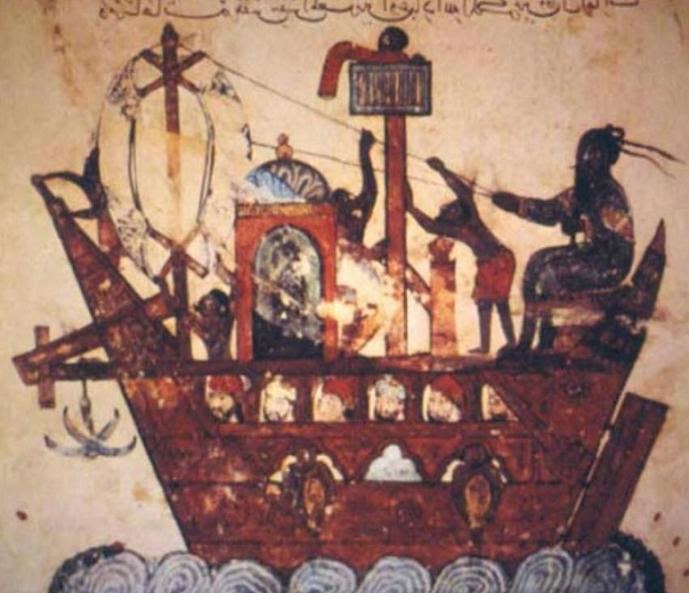
The Hariri Ship, the first known picture of an Arab sailing vessel.
The traditional boats of the Gulf are obviously neither Islamic in any way nor are they elements of Gulf architecture. However, they seem to me to have so much in common with traditional Gulf architecture and the way of life prior to development irrevocably changed the life of Qataris. In this sense I see boats being as important as the traditional architecture, and I feel that they should be looked at in parallel with land-based architecture.
The navy of the Fatimid Caliphate was one of the most developed early Muslim navies and a major military force in the central and eastern Mediterranean in the 10th–12th centuries. As with the dynasty it served, its history can be distinguished into two phases. The first period, from c. 909 to 969, when the Fatimids were based in Ifriqiya (modern Tunisia), and the second period, lasting until the end of the dynasty in 1171, when the Fatimids were based in Egypt. During the first period, the navy was employed mainly in the constant warfare with the Byzantine Empire in Sicily and southern Italy, where the Fatimids enjoyed mixed success, as well as in the initially unsuccessful attempts to conquer Egypt from the Abbasids and the brief clashes with the Umayyad Caliphate of Córdoba.
During the first decades after the eventual Fatimid conquest of Egypt in 969, the main naval enemy remained the Byzantines, but the war was fought mostly on land over control of Syria, and naval operations were limited to maintaining Fatimid control over the coastal cities of the Levant. Warfare with the Byzantines ended after 1000 with a series of truces, and the navy became once more important with the arrival of the Crusaders in the Holy Land in the late 1090s.
Despite it being well funded and equipped, and one of the few standing navies of its time, a combination of technological and geographical factors prohibited the Fatimid navy from being able to secure supremacy at sea, or interdict the Crusaders’ maritime lines of communication to Western Europe. The Fatimids retained a sizeable navy almost up to the end of the regime, but most of the fleet, and its great arsenal, went up in flames in the destruction of Fustat in 1169.
Organization
During the early centuries of Islam, the navies of the caliphates and the autonomous emirates were structured along similar lines. Generally, a fleet (al-usṭūl) was placed under the command of a “head of the fleet” (rāʾis al-usṭūl) and a number of officers (al-quwwād, singular al-qaʿīd), but the chief professional officer was the “commander of the sailors” (qaʿīd al-nawātiya), who was in charge of weapons and manoeuvres. Crews comprised sailors (al-nawātiya, singular nūtī), oarsmen (qadhdhāf), worksmen (dhawu al-ṣināʿa wa’l-mihan), and marines for on-board combat and landing operations, including men charged with deploying incendiary substances (al-naffāṭūn, “naphtha men”).
During the Ifriqiyan period, the main base and arsenal of the Fatimid navy was the port city of Mahdiya, founded in 913 by al-Mahdi Billah.[28][29] Apart from Mahdiya, Tripoli also appears as an important naval base, while in Sicily, the capital Palermo was the most important base. Later historians like Ibn Khaldun and al-Maqrizi attribute to al-Mahdi and his successors the construction of vast fleets numbering 600 or even 900 ships, but this is obviously an exaggeration and reflects more the impression subsequent generations retained of Fatimid sea-power than actual reality during the 10th century. In fact, the only references in near-contemporary sources about construction of ships at Mahdiya are in regard to the scarcity of wood, which delayed or even stopped construction, and necessitated the import of timber not only from Sicily, but from as far as India.
The governor of Mahdiya—from 948/9 the post was held by the eunuch chamberlain and chief administrator Jawdhar—seems to have also entailed the supervision of the arsenal and naval affairs in general. A certain Husayn ibn Ya’qub is called ṣāḥib al-baḥr (“lord of the sea”) and mutawallī al-baḥr (“supervisor of the sea”) in the sources, but his exact role is unclear. He was clearly a subordinate of Jawdhar, but despite his title does not appear to have actively commanded the fleet, and his tasks were probably more related with administration or ship construction. Given the focus of Fatimid naval activities against the Byzantines in southern Italy, actual command of the fleet was apparently in the hands of the governor of Sicily.
The structure of the navy in the lower ranks is equally obscure. Based on the breakdown of the prisoners captured off Rosetta in 920, the crews appear to have been recruited in Sicily and the ports of Tripoli and Barqa, while the bulk of the fighting troops was composed of the Kutama Berbers—the main supporters of the Fatimid regime—and the Juwayla, black Africans (Sudān) recruited into the Fatimid military. As Yaacov Lev comments, this may provide some insight into the generally poor performance of the Fatimid fleets in the early years of the regime: the Kutama were loyal but inexperienced at sea, while the crews, drawn from the maritime populations newly under Fatimid control, were politically unreliable. Furthermore, it appears that the quality of the naval crews suffered as recruitment into the navy was forcible and unpopular. It also tended to affect mostly the lower classes, among whom, as Lev summarizes it, “[t]he navy was despised and naval service was regarded as a calamity”